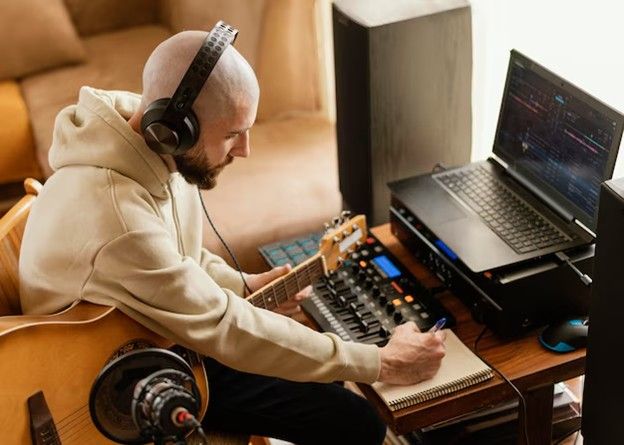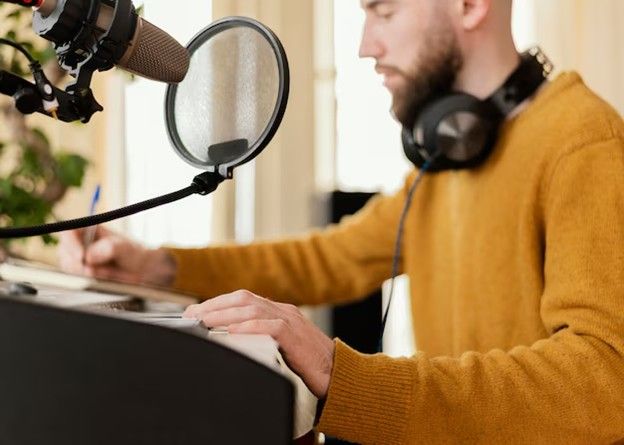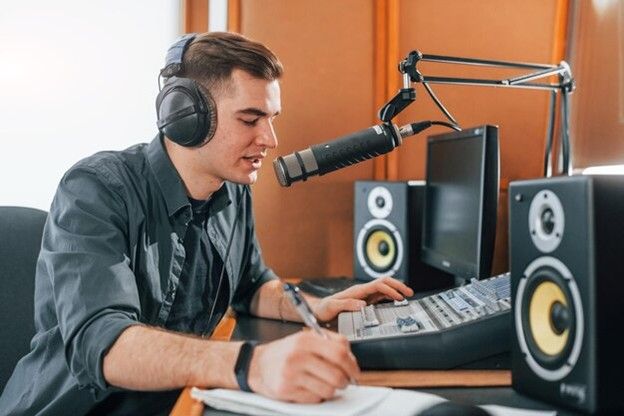Raw audio recordings are polished to improve clarity, engagement, and professionalism—a process known as podcasting editing. It calls for cutting pointless bits, changing volume settings, and lowering background noise. Skipping the editing procedure won't help your podcast sound professional. Listeners expect clear, distraction-free audio, hence, one of the main causes of people stopping to listen is inadequate sound quality.
Podcast editing is essential for storytelling, even beyond the enhancement of audio quality. A well-edited podcast is seamless, free of distractions, and keeps listeners interested. Editing lets you straighten dialogues, eliminate dead air, and guarantee clear delivery of your message. Good editing improves the listening experience and helps your material be more digestible, whether it's for a monologue, an interview, or a discussion-based program.
Research indicates that podcasts with excellent production retain 35% more listeners than those with badly edited audio. Good editing can make all the difference between a show that thrives and one that struggles to keep an audience in a competitive podcasting environment where thousands of fresh episodes are published every day.
The Key Elements of Editing a Podcast
Cutting and Sequencing for Storytelling
Editing a podcast goes beyond simply cutting out extended pauses. Your episode's organization affects participation and narrative. Eliminating filler words, uncomfortable pauses, or repeating phrases helps to keep the dialogue flowing and interesting. The aim is to provide coherence and clarity while yet preserving a natural flow.
Many times, podcast editors reorganize pieces to enhance the narrative. For better impact, an interview section might be changed sooner if, for instance, an essential lesson emerges but seems too late in the show. Good sequencing guarantees that listeners remain interested all through and improves pace.
Enhancing Audio Clarity and Removing Distractions
Podcasts loaded with background noise, static, or irregular audio levels are not appealing to anyone. Using a high-quality microphone like the USB & XLR Condenser Microphone ensures crisp recordings, reducing the need for excessive post-production work. Eliminating background noise, stutters, and coughing helps your podcast sound polished.
Many editing techniques, including de-essers and noise gates, help to filter undesired background noise or smooth down sharp sounds. A polished, professional audio output depends on these tools absolutely.
Mixing and Balancing Different Sound Elements
A podcast goes beyond voice recordings. Transitions, sound effects, and music help to improve listening conditions. In podcast audio editing, juggling all these components—voice, music, and effects—is really vital. Using tools like a Portable Audio Mixer allows you to refine your audio in real-time, reducing editing time later.
Although they may create an immersive podcast, sound effects and music should be used deliberately. Background music should never overwhelm speech; transitions should feel natural rather than abrupt. Maintaining a satisfying listening experience depends on consistent audio levels across several areas.
How to Edit Podcast: A Step-by-Step Process

Preparing for Podcast Editing
Setting Up Your Recording Environment for Minimal Editing
Editing starts before you even hit record. A noisy environment means more work in post-production. Investing in proper equipment like a Wireless Microphone or 4K Streaming Camera for Webcam Use ensures clean audio and video quality. Soundproofing your recording space and using pop filters can reduce unwanted noise.
Years of editing are saved by a regulated recording environment. Recording quality can be much improved by lowering echoes using acoustic foam panels, removing plosive noises with a pop filter, and orienting your microphone. Recording clean audio will help to enable editing to be more of fine-tuning than resolving significant problems.
Organizing Audio Files and Selecting the Right Software
Sort your files before doing any editing. Correctly label your recordings and keep them in a place you will find handy. Select editing tools that fit your degree of skill. While pros might like Adobe Audition or Reaper, beginners will find Audacity to be rather welcoming.
Essential capabilities included in editing software should be multi-track editing, noise reduction, EQ changes, and compression choices. Certain podcasters employ AI-powered tools to expedite simple editing chores, including standardizing volume levels or eliminating filler words.
Shining your raw recording into a cogent and interesting episode comes first in podcast audio mixing. Listeners want a seamless flow of discussion free of awkward transitions, fillers, or pauses. Should the pace seem odd, you run the danger of losing theirs. Ensuring your material is interesting from beginning to end depends critically on editing.
Trimming Excess Content
One of the most important tasks in editing is cutting out unnecessary portions of the conversation. This covers long pauses, repeated phrases, and filler words like "um,," "uh,," "you know,," or "like." Although these fillers abound in real conversation, too many could make your podcast seem unpolished or meandering.
Still, the objective is not to eliminate all natural pauses; some stillness is required to establish rhythm and let significant points sink in. The difficulty is striking the proper mix between a clear, interesting delivery and a genuine, conversational tone.
Keeping the Conversation Focused
Long-windy explanations, off-topic debates, or tangents could weaken the major points of your episode. Think about tightening rather than wiping off whole portions. Cutting certain elements while maintaining the core can make the segment more powerful if a guest takes too long to reach a vital point.
Ask yourself whether your episode stays succinct and direct to guarantee this.
- Does this section support the episode's major theme?
- Should this part continue too long, listeners would lose interest.
- Is it possible to simplify this explanation while yet maintaining clarity?
Ensuring Smooth Transitions
Editing should produce flawless transitions between several episode segments. The listening process might be startling, with sudden cuts or uncomfortable leaps between subjects. Including mild background music or natural fade-ins and fade-outs to link parts will help to stop this.
Including a brief narrative—such as "Now let's move on to...," or "That brings us to..."—can help listeners traverse the program without incident if two sections feel disjointed.
Enhancing Speech Clarity and Removing Disruptions

Good podcasting editing starts with a clear, balanced voice. Cleaning up speech clarity is crucial even with the best microphone configuration since undesired noise can be captured.
Noise Reduction and Clean Audio Capture
Before you start editing, it's important to use high-quality recording equipment. A USB Microphone for Streaming and Podcasting ensures a crisper, cleaner sound, reducing the need for heavy post-processing.
Noise gates and de-noisers enable editors to remove undesired background noise, including:
- Room echo or reverb
- Humming from a fan or device
- Low-frequency rumbles derived from vibrations
- Noise from traffic or outside disturbances
Record in a quiet, controlled atmosphere if at all feasible to reduce the need for heavy editing later on.
Balancing Audio Levels for Consistency
Have you ever listened to a podcast where one speaker sounds far louder than the other? This is a typical problem when co-hosts or visitors use various mics or talk at different volumes. Making sure all voices are at the same level throughout the episode is known as volume normalizing.
Although manually balancing loudness can take time, audio editing programs such as Adobe Audition, Audacity, or Reaper can assist in automating this task. By means of an audio compressor, one can also homogenize fluctuations in loudness, therefore guaranteeing a consistent sound over the whole episode.
Removing Unwanted Breathing and Mouth Sounds
Many podcasters are unaware of how lip smacks, mouth clicks, and breathing noises could compromise audio quality. Although natural breathing sounds are expected, gasps, sighs, or inhales that are too strong may cause distraction.
Editing tools let you physically cut out or lessen these distractions. Another tip is to use a high-quality microphone with a pop filter, like the USB & XLR Condenser Microphone, which minimizes plosive sounds and reduces the need for post-editing corrections.
Final Thoughts on Podcast Editing Basics

Cutting, organizing, and polishing the basic audio for clarity and smoothness forms the initial phase of editing podcast. Your podcast will sound polished and professional if you concentrate on cutting pointless material, keeping a natural yet interesting flow, and lowering distractions.
Once this stage is over, sound design and mixing—which adds creative elements like music and sound effects to improve storytelling and audience involvement—will propel your podcast to the next level.
Conclusion
Editing audio for podcasts is about creating a smooth listening experience that keeps your audience interested, not only about fixing mistakes. Every stage of the editing process improves the quality of your podcast, from arranging talks for improved flow to controlling audio levels and removing distractions. A well-edited show guarantees your message is delivered clearly, increases credibility, and draws more viewers.
Investing in high-quality recording equipment like the USB & XLR Condenser Microphone and using effective editing techniques will significantly reduce post-production work. While editing can be time-consuming, the payoff is a professional-sounding podcast that stands out in an increasingly competitive space.
The secret is consistency, whether you're outsourcing to experts or editing your podcast on your own. Keep improving your approach, remain receptive to learning new skills, and concentrate on producing worthwhile materials. A great podcast is about your presentation of the material, not only about what you say.







































































